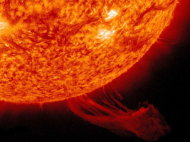Earth Is Closest to the Sun for 2013 Today
By Geoff Gaherty | SPACE.com – 4 hrs ago
If the sun looks a little larger than usual today, you're not seeing
things. Today (Jan. 2) marks the time when the Earth is at perihelion,
the point in its orbit at which it is closest to the sun.
During perihelion, the Earth is exactly 91,402,560 miles (147,098,161
kilometers) from the sun.In actuality, you most likely can't see any
difference between the apparent size of the sun
today and its appearance at aphelion (when the Earth will be farthest
from the star).The difference is only 3.4 percent, too small to be
detected with the naked eye.
On average, the Earth
is about 93 million miles (150 million km) from the sun. It will be
farthest from the sun on July 5, when the Earth reaches aphelion, a
point 94,508,960 miles (152,097,427 km) from the sun. The closest and
farthest differences from the sun are very similar because the Earth’s
orbit is very close to being circular. In fact, as planetary orbits go,
ours is close to perfect.
The eccentric Earth
Only Venus and Neptune have more circular orbits than the Earth. On the
other hand, if you look at the diagram of the orbits of the four inner
planets accompanying this story, you may easily see that Mercury and
Mars have orbits which are seriously eccentric.
Astronomers use the term "eccentric" in its original mathematical
sense, meaning "away from the center." A perfect circle has an
eccentricity of 0. A straight line would have an eccentricity of 1.
Everything else in between is an oval of some kind.
Here's a look at the innermost planets of the solar system in order of increasing eccentricity:Venus: 0.006785
Earth: 0.016677
Mars: 0.093277
Mercury: 0.205649
Looking at the diagram, the orbits of Earth and Venus look almost perfectly circular, while that of Mars is slightly closer to the sun towards the bottom. Mercury's orbit is very much closer to the sun on the right. If you look closely, there is a little tick mark on the orbits to indicate where perihelion lies. Don't confuse this mark with the little wedges which denote the orbital nodes, the points where the orbits cross the plane of the ecliptic. The Earth appears right next to the tick mark on its orbit marking perihelion in the image.
Closer to the sun
So what is the difference for the inhabitants of Earth when our planet is at perihelion instead of aphelion? The Earth is slightly warmer than it would be otherwise, about 4 degrees Fahrenheit (2.3 degrees Celsius). [Earth Quiz: How Well Do You Know Our Planet?]
This perihelion effect is very minor compared to the effects of the
tilt of our planet's axis. During December in the Northern Hemisphere,
the North Pole is tilted away from the sun so that we receive less
sunlight every day.
At the same time, the South Pole is tilted towards the sun, so the
Southern Hemisphere receives more sun and experiences summer. In June,
the situation is reversed and we have summer in the northern hemisphere
and winter in the southern hemisphere.
The only effect of perihelion is that the winters in the Northern
Hemisphere are very slightly milder than the winters in the southern
hemisphere at the equivalent latitudes. Not as many people live as close
to the South Pole as do close to the North Pole, so humanity isn't
affected much.
So enjoy that "big" January sun, and look forward to the longer days to
come as Earth moves around its orbit to the point where we really
receive more sun and spring arrives.




No comments:
Post a Comment